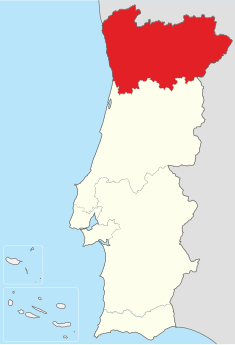North of Portugal
| Norte | |
| Região Norte | |
| NUTS II Region (Região) | |
|
The Douro Valley, where port wine is produced
|
|
| Name origin: norte, Portuguese for north | |
| Country | |
|---|---|
| Region | North |
| Capital | Porto |
| - coordinates | 41°8′59″N 8°36′36″W / 41.14972°N 8.61000°WCoordinates: 41°8′59″N 8°36′36″W / 41.14972°N 8.61000°W |
| Lowest point | Sea level |
| - location | Atlantic Ocean |
| Area | 21,278 km2 (8,215 sq mi) |
| Population | 3,689,173 (2011) |
| Density | 173.38/km2 (449/sq mi) |
| Timezone | WET (UTC+0) |
| - summer (DST) | WEST (UTC+1) |
| ISO | PT |
| NUTS | PT11 |
| GDP (PPP) | 2013 estimate |
| - Total | € 61.745 billion |
| - Per capita | € 16,900 |
| GDP (nominal) | 2013 estimate |
| - Total | € 48.148 billion> |
| - Per capita | € 13,200 |
|
Location of the Norte Region
|
|
| Statistics from INE (2005); geographic detail from Instituto Geográfico Português (2010) | |
Norte (Portuguese: Região Norte, IPA: [ʁɨʒiˈɐ̃w̃ ˈnɔɾtɨ]; "North Region") or Northern Portugal is the most populous region in Portugal, ahead of Lisboa, and the third most extensive by area. The region has 3,689,173 inhabitants according to the 2011 census, and its area is 21,278 km² (density of 173 inhabitants per square kilometre). It is one of five regions of Mainland Portugal (NUTS II subdivisions). Its main population center is the urban area of Porto, with about one million inhabitants; it includes a larger political metropolitan region with 1.8 million, and an urban-metropolitan agglomeration with 2.99 million inhabitants, including Porto and a number of urban areas in Northwestern Portugal, ranging from Braga to Aveiro. The Commission of Regional Coordination of the North (CCDR-N) is the agency that coordinates environmental policies, land-use planning, cities and the overall development of this region, supporting local governments and associations.
Northern Portugal is a culturally varied region. It is a land of dense vegetation and profound historic and cultural wealth. What is now Northern Portugal was first settled by various pre-Celtic and Celtic tribes before being explored by a number of Mediterranean civilizations, including Greek settlements in its river-mouths, trade with the Carthaginians, conquest by the Romans, invasion by Germanic peoples, and attacks by the Moors and the Vikings.
The region has been inhabited since prehistoric times and is a key area for the understanding of both Atlantic European, Megalithic and Castro cultures. Historically, Northern Portugal, with Galicia in Spain, made up the Kingdom of Galicia. In protohistoric times, it was inhabited by Gallaeci tribes, related with the Lusitanians, and it corresponds roughly to Conventus Bracarensis of Roman Gallaecia. The historical Suebic Kingdom (5th-6th centuries AD) had its capital in the now Portuguese city of Braga and most of these migrants and invaders established themselves in Littoral Northern Portugal, when the Roman empire collapsed. After the Islamic conquest of the Iberian Peninsula, a small county was established around the city of Porto, which still in the 10th century expanded and became a government, the County of Portugal. This county grew in ambition and it was where Portugal's first king, Dom Afonso Henriques, established the Portuguese kingdom and stated the southward expansion. The Portuguese language developed in this area, and has a specific modern dialect, Northern Portuguese, taken down south as the Portuguese Kingdom expanded, namely after Afonso Henriques era.
...
Wikipedia


